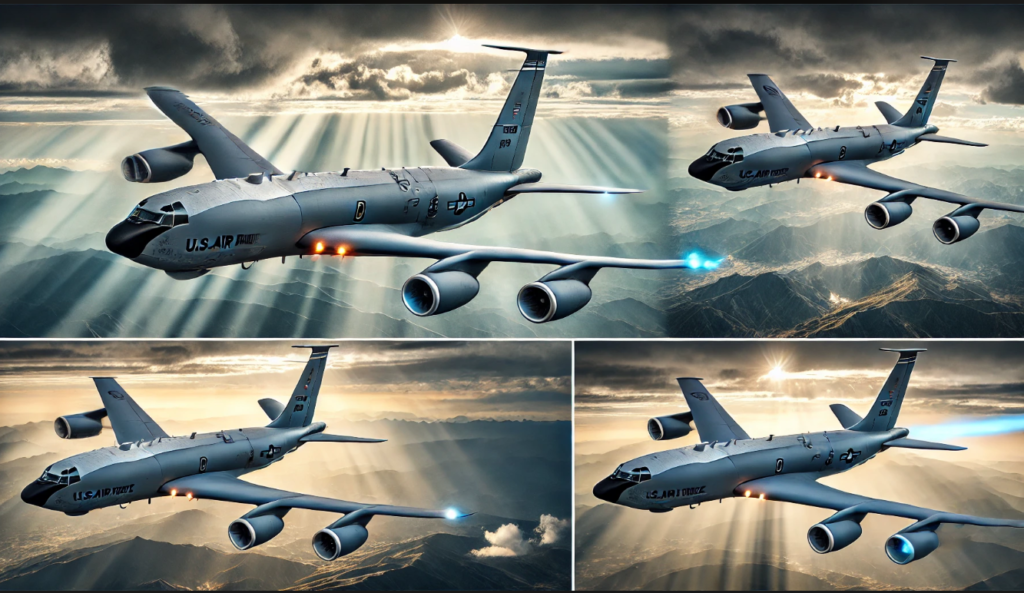
Introduction
The U.S. Air Force’s WC-135R, nicknamed the “Nuke Sniffer,” is an indispensable part of modern national security efforts. This specialized aircraft is designed to detect nuclear explosions and track radioactive particles in the atmosphere. Through its sophisticated equipment, it plays a crucial role in identifying and analyzing potential nuclear threats, providing valuable data for monitoring nuclear activities worldwide.
1. History and Origins of the “Nuke Sniffer” Aircraft
Cold War and the Search for Nuclear Tests
During the tense geopolitical era of the 1950s, known as the Cold War, the United States and the Soviet Union engaged in a race to establish nuclear dominance. During this time, the U.S. Air Force used a WB-29 reconnaissance aircraft to detect radioactive particles in the atmosphere. This mission, covering flights from Japan to Alaska, marked the first detection of a Soviet nuclear test in September 1949, significantly advancing nuclear monitoring efforts.
The Development and Initiation of the “Constant Phoenix” Program
Following these early findings, the U.S. Air Force launched the “Constant Phoenix” program, aiming to create an aircraft capable of identifying traces of nuclear explosions. The WC-135R became an integral part of this program, evolving through multiple technological upgrades to enhance its capability for nuclear detection.
2. Design and Technical Features of the WC-135R “Constant Phoenix”
Technical Specifications
The WC-135R is meticulously designed for the precise identification of radioactive particles in the atmosphere. Equipped with advanced sensors and monitoring equipment, the aircraft can detect and analyze radioactive debris from nuclear tests with high accuracy. Some of its key features include:
- Advanced Sensors and Radioactive Measurement Equipment: The aircraft carries specialized sensors that detect radioactive particles and measure their concentration.
- Flight Data Recording System: This system collects atmospheric data, which experts later analyze to identify nuclear activities.
- Long-Range and High-Altitude Capabilities: The WC-135R is optimized for high-altitude, long-distance flights, allowing it to monitor nuclear particles over vast areas.
Collection and Analysis of Radioactive Particles
Onboard equipment collects radioactive particles from the atmosphere, which are then transported to cutting-edge laboratories, such as those at Patrick Space Force Base. There, scientists analyze the particles to detect potential nuclear activity and assess global security risks.
3. Operational Scope and Current Missions of the WC-135R
Adhering to International Treaties
The monitoring flights of the WC-135R help enforce the 1963 Limited Nuclear Test Ban Treaty, which prohibits nuclear weapon tests in the atmosphere, underwater, and in outer space. The aircraft’s missions span multiple regions, ensuring adherence to these treaties and helping to detect any violations.
Primary Missions
- Monitoring Nuclear Tests: The WC-135R’s primary function is to identify and monitor nuclear tests globally.
- Sampling Radioactive Dust: In the event of a nuclear explosion, the aircraft gathers radioactive dust and particles dispersed in the atmosphere.
- Data Collection and Analysis: Atmospheric data gathered by the WC-135R allows experts to study radioactive elements and evaluate potential threats.
4. North Korea’s Missile Tests and the Role of the WC-135R
On October 31, North Korea conducted an intercontinental ballistic missile test, violating United Nations Security Council resolutions. This incident underlined the critical role of the WC-135R, which continuously monitors such activities. In the event of a potential nuclear test, the aircraft is immediately activated to collect data.
Enhancing Deterrence and Security
The presence of the WC-135R exerts pressure on other nations, discouraging them from violating international treaties. The aircraft serves as a powerful deterrent, reducing the likelihood of nuclear tests and reinforcing global stability.
5. Global Security Contributions of the WC-135R
Contributions to National and International Security
The WC-135R is not only essential to U.S. national security but also plays a significant role on a global scale. The aircraft can detect nuclear tests in any country, supporting international efforts to maintain global peace and stability.
Collaborations with Other Nations
The U.S. has used the WC-135R in collaboration with other countries for various security missions. These partnerships have helped enhance nuclear test monitoring, contributing to global security efforts and strengthening diplomatic relations.
6. Future Applications of the “Nuke Sniffer”
Incorporation of New Technologies
Future upgrades are planned to further advance the WC-135R’s capabilities. With new technology, the aircraft will not only be able to analyze radioactive particles in the atmosphere but also in water and outer space, extending its monitoring scope.
Supporting Global Treaties
The WC-135R will continue supporting international nuclear test ban treaties. By helping enforce these agreements, the aircraft will contribute to a more stable and peaceful world.
Conclusion
The WC-135R “Nuke Sniffer” aircraft is a vital part of modern security systems. Its primary mission is not only to detect nuclear explosions but also to support international peace and stability. By analyzing radioactive particles and monitoring nuclear tests, the WC-135R ensures compliance with international treaties.
In today’s world, where the threat of nuclear weapons remains, the role of aircraft like the WC-135R becomes exceedingly important. This aircraft is a sentinel of both American and global security, allowing timely response to potential nuclear threats.
Looking to the future, the WC-135R is set for further technological enhancement, ensuring its relevance in a rapidly evolving security landscape. The aircraft serves as a “messenger of peace,” striving to protect the world from the dangers of nuclear weapons. Thus, the WC-135R “Constant Phoenix” aircraft will remain an essential security tool for both the present and the future.

Average Rating